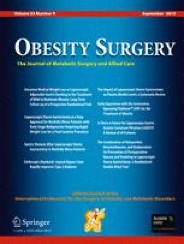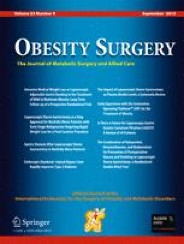Complications spécifiques
- Fistule anastomotique ou manque d'étanchéité du montage chirurgical (1%)
Signes : Douleur abdominale, Fièvre, Impossibilité de manger, Douleur épaule gauche
Necessité d'un traitement spécifique qui va du traitement antibiotique...ou un traitement endoscopique (Prothèse Queue de Cochon)....jusqu'a la reprise chirurgicale. En raison d'un montage haute pression, cette complication est difficile et longue à traiter dans les Sleeves. Dans les Bypass, montage basse pression, cette complication est plus simple à traiter.
- Occlusion digestive (Bypass)
- Intolerance alimentaire transitoire ou par torsion du montage chirurgicale (Sleeve)
 Multidisciplinary Management of Leaks After One-Anastomosis Gastric Bypass in a Single-Center Series of 2780 Consecutive Patients
Multidisciplinary Management of Leaks After One-Anastomosis Gastric Bypass in a Single-Center Series of 2780 Consecutive Patients
A.Liagre, M.Queralto, G.Juglard, Y.Anduze, A.Iannelli, F. Martini
Purpose : Few data exist in the literature concerning leaks after one-anastomosis gastric bypass (OAGB). Our aim was to describe the incidence, presentation, and management of leaks after OAGB.
Methods : Between May 2010 and December 2017, 2780 consecutive patients underwent OAGB. A retrospective chart review was performed on the 46 patients (1.7%) who experienced postoperative leaks.
Results : Leaks arose from the anastomosis in 6 cases (13%) and from the gastric pouch in 27 cases (59%), while the remaining 13 patients (28%) had leaks from an undetermined origin. Management followed a standardized algorithm taking into consideration the clinical situation and findings on an oral contrast computed tomography (CT) scan. All patients were treated by fasting, total parenteral nutrition, and antimicrobial therapy. Nine patients (20%) could be managed by medical treatment only, 13 patients (28%) underwent laparoscopic management (washout and drainage plus T-tube placement in 5 cases or conversion to Roux-en-Y gastric bypass (RYGB) in one case). The remaining 23 patients (50%) were managed by percutaneous drainage and/or endoscopy. No mortality was observed; the major morbidity rate was 20%. The median length of a hospital stay was 17 days (5–80).
Conclusion : Management of leaks after OAGB depends on clinical conditions and presence, size, and location of an abscess and/or a fistula. If endoscopy and interventional radiology are available, reoperation can be avoided in most patients. In most leaks at the gastrojejunal anastomosis, inserting a T-tube in the leak orifice avoids the necessity for conversion to RYGB.
Rendez-vous
05 62 13 31 70
Centre Digestif de la Clinique des Cèdres
Château d’Alliez
31700 CORNEBARRIEU
Accéder au Cabinet
Complications non spécifiques
- Hemorragie
- Infection pulmonaire ou urinaire
- Maladie thrombo-embolique (Phlébite ou Embolie pulmonaire)
 Treatment of Persistent Large Gastrocutaneous Fistulas After Bariatric Surgery: Preliminary Experience with Endoscopic Kehr’s T-Tube Placement
Treatment of Persistent Large Gastrocutaneous Fistulas After Bariatric Surgery: Preliminary Experience with Endoscopic Kehr’s T-Tube Placement
A.Liagre, M.Queralto, J.Levy, G.Juglard, F.Martini

